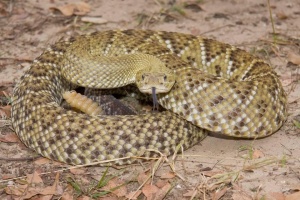Living in the Tropics
Silent Danger: Nayarit Coral Snake
Tara A. Spears
Nothing creeps out most people than the surprise appearance of a slithering snake. It is bad enough when it’s a harmless reptile but when it is a deadly viper, the encounter is terrifying. Sure, I knew that there are rattlesnakes in Mexico; I didn’t know there were other more lethal snakes, too. I just hadn’t thought about the possibility of snakes that would come into the yard! My gardener killed FOUR of the very toxic Nayarit Coral snakes (Serpiente coralillo nayarita) in one hour, only a few meters from the house. I’ve been on a mission ever since to warn people to be on the lookout when they are outdoors.
Coral snakes (Micrurus proximans) are small, vibrantly colored, highly venomous snakes. They have the second-strongest venom of any snake (the black mamba has the most deadly venom), but corals are generally considered less dangerous than rattlesnakes because the coral snakes have a less effective poison-delivery system. Mexico is home to over 60 different species of Coral Snakes, all venomous, all bite, some can kill. These bright colored snakes have a fixed front- fang to inject the venom. The venom from the Coral Snake is a neurotoxin, and will immediately begin to attack your breathing system.
My gardener said, “In Mexico, corals are called the twenty minute snake, because after you have been bitten, you will be dead within twenty minutes.” I couldn’t find any support for this time-frame, but the venom is fast acting making it important to seek immediate medical attention.
Coral snakes are slender and small, typically between 10 and 20 inches long (40 to 50 centimeters), with some species reaching 3 feet (1 meter). According to Desert USA magazine, the Western coral snake can be as skinny as a pencil. They have bulbous, almost-neckless heads, rounded noses and similar-looking tails, meaning that it can be hard to tell a snake’s head from its tail.
The most distinctive physical characteristics of coral snakes are their brightly colored and patterned bodies, short, fixed fangs and potent venom, according to Viernum. While only some species have elements of coral coloring, all species have eye-catching patterns and colors: red bands flanked by yellow bands.
Many sources said a rhyme was penned “as a way for people to quickly and easily differentiate between a nonvenomous snake and the toxic coral snake.” One version of the rhyme goes: Red on yellow can kill a fellow; Red on black, friend of Jack.![]()
Coral snakes prefer to live in forested or jungle areas and spend most of their time burrowed underground or in leaf piles, according to the University of Michigan Zoology web.
Coral snakes are nocturnal and reclusive. Because of their secretive habits, they may be found in suburban areas and into residential areas. They spend most of their time keeping cozy in burrows or under rocks or rotting leaves. Coral snakes eat lizards and other small, smoothed-scaled snakes.
Unlike many other venomous snakes that give birth to live young, coral snakes lay eggs. According to National Geographic, coral snakes are the only venomous snakes in North America to do so. Eastern coral snakes lay six or seven eggs in the summer that hatch in early fall. Western coral snakes lay two to three eggs. Babies are born brightly colored, fully venomous, and 7 inches (17 cm) long.
Coral snakes’ small, fixed fangs and small mouth mean that it is difficult for them to puncture human skin — let alone leather boots. Humans are mostly bitten when trying to pick up a coral snake. Because of their small size, these snakes don’t carry much venom in their fangs, so they may try to hold onto their victim for some time.
The snake’s neurotoxic venom causes rapid paralysis and respiratory failure in its prey; however, according to the National Institute of Health, it can take many hours for symptoms to appear in humans. Additionally, there is often little or no pain or swelling in humans from a coral snake bite. If untreated by anti-venom, however, symptoms will take effect. The reaction to coral venom will include slurred speech, double vision, and muscular paralysis.
Always be on the lookout for your enemies being close to you, especially after dark. Coral snakes are often so secretive that it might actually be present in an area in fair numbers yet its existence may be unsuspected.
As if rattlesnakes and coral snakes aren’t bad enough, be aware that Jaltemba Bay is also home to wild pythons. I was stunned to learn this fact myself; a friend had one in her yard this summer! If I had given the idea of wild dangerous reptiles some thought, I would have remembered that the world record for the largest living snake was in Mexico, just a couple of years ago, so of course we have dangerous reptiles here.


The presence of venom creatures doesn’t mean that you can’t enjoy taking your morning exercise outdoors or evening strolls; just be alert for wild creatures napping on rock fences or lying along the uncut weeds in the empty lots in town. Try not to let your pets explore off leash and check them for punctures if their behavior suddenly changes.
I now believe that it was a Coral snake bite that killed my little Strella earlier this summer. Local vet, Dr. Aldo Barba, said that he can help an animal with snake bite if you act quickly.
Always be on the lookout for these enemies being close to you, especially after dark. Coral snakes are often so secretive that it might actually be present in an area in fair numbers yet its existence may be unsuspected.
Compare the dangerous Coral snake on the left to the harmless Mock coral on the right: